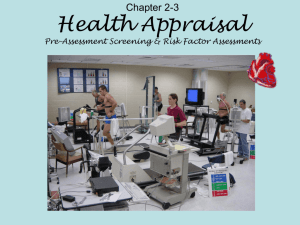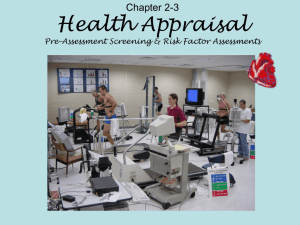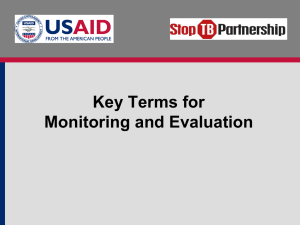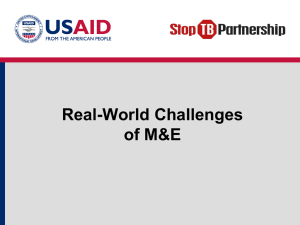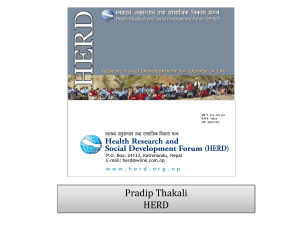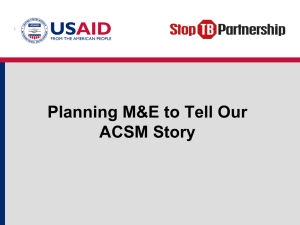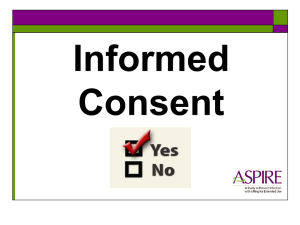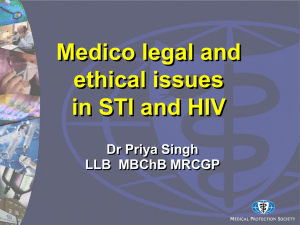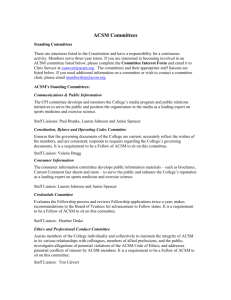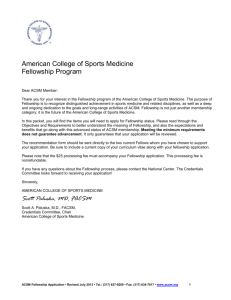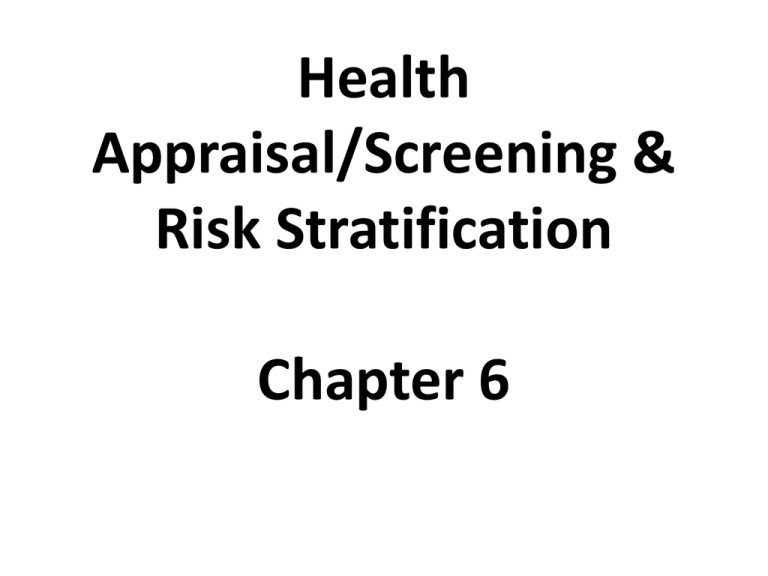
Health
Appraisal/Screening &
Risk Stratification
Chapter 6
Pre-participation Health Screening Purpose
• Identification individuals w/
– medical contraindications to exercise
– ↑d risk for disease
• age, symptoms, &/or risk factors
• medical evaluation & exercise testing before starting
an exercise program
– clinically significant disease
• participate in medically supervised exercise pgm
– other special needs
Parts of Informed Consent for Exercise
Training
•
•
•
•
•
•
Purpose & explanation of procedure
Risks
Benefits
Alternatives available
Confidentiality & use of information
Inquiries & freedom of consent
Parts of Informed Consent for Exercise
Training
• Purpose & explanation of procedure
– What are they consenting to
– What does it consist of or include
– What are they agreeing to
– Expectations of program & participant
– State that participant has been advised
Consent
• Legally effective agreement of the participant
or the participant’s legally authorized
representative based on information that is
given to the participant or the representative
in language that is understandable.
Parts of Informed Consent for Exercise
Training
• Risks
– Adverse Δs during exercise
• Abnormal BP
• Fainting
• Disorders of rhythm
• Stroke
• Heart attack
• Death
– Efforts made to minimize occurrences
– Knowing of these risks, it is my desire to proceed
Parts of Informed Consent for Exercise
Training
• Benefits
–May or may not obtain health or
fitness benefits
–But, list likely benefits of exercise
training
Parts of Informed Consent for
Exercise Training
• Alternatives available
–Not attend
–Do on own
–Go elsewhere
Parts of Informed Consent for Exercise
Training
• Confidentiality & use of information
– Information is privileged & confidential
– Will not be released w/o written consent
– Information only used by program staff
– Research & statistics w/o PHI (Personal
History Information)
Parts of Informed Consent for
Exercise Training
• Signatures
–Patient
–Witness
–Staff member
–Parent/Guardian
Valid Informed Consent
• Be of lawful age
• Not be mentally incapacitated
• Know & fully comprehend the importance &
relevance of the material risks
• Give consent voluntarily & not under any
mistake of fact or duress
Informed Consent - Administration
• Private, quiet setting
• Document completion
– Reading
– Verbal explanation
– Opportunity to ask questions
– Signing and dating
– Presentation of copy
Informed Consent - Limitations
• Does not provide legal immunity
• Does provide evidence that client
was made aware
• Negligence – not covered
• Legal counsel
Pre-activity Screening
• Gathering
– Demographics
– Health-related information
• Aid decision making for assessment &
exercise
Preparticipation Health Screening &
Risk Stratification
• American College of Sports Medicine (ACSM)
• American Heart Association (AHA)
• American Association of Cardiovascular &
Pulmonary Rehabilitation (AACVPR)
Therefore; Preparticipation Health Screening
Include
• Medical contraindications to exercise
• ↑d risk for disease
– Age
– Symptoms
– Risk factors
• Clinically significant disease
• Special needs
Health Screening
Self-administered questionnaires
Sophisticated diagnostic tests
Health Screening
Nature & extent of appraisal
• Age
• Sex
• Perceived health status of participants
• Resources
– Economic
– Personnel
– Equipment
Components of Pre-Activity
Screening
• Medical History/Health Habits
Questionnaire
• Physical Activity Readiness
Questionnaire (PAR-Q)
• Medical/Health Exam
Health History Questionnaire
•
•
•
•
•
•
Family Hx
History of diseases & illnesses
Surgical History
Past & present health habits
Medications
Signs & symptoms
– (next slide – review p 25)
Physical Activity Readiness
Questionnaire (PAR-Q)
(
Recommended as a minimum standard
for entry into moderate-intensity
exercise programs
Designed to identify small number of
adults for whom PA might be
inappropriate
(next slide – review p 26)
Physical Assessment & Laboratory Tests
• Resting HR
• Resting BP
• Lung Capacity
–FVC
–FEV1
–MVV
•
Blood Tests
• TC
• LDL
• HDL
• TC/HDL Ratio
• Glucose
Absolute Contraindications to Exercise
Testing
•
•
•
•
•
•
•
•
•
•
•
Acute MI (w/n 2 days)
Unstable angina
Uncontrolled arrhythmias
Active endocarditis
Severe AS
Symptomatic HF
Acute pulmonary embolus or pulmonary infarction
Acute non-cardiac disorders
Acute myocarditis or pericarditis
Physical disability
Inability to obtain consent
Relative Contraindications to Exercise
Testing
•
•
•
•
•
•
•
•
•
Left main disease or equivalent
Moderate stenotic valve disease
Electrolyte abnormalities
Tachyarrhythmias or bradyarrhythmias
A-Fib with uncontrolled ventricular rate
HOCM
Mental impairment – can’t cooperate
High-degree AV block
Severe HTN: SBP > 200 mmHg; DBP > 110 mmHg
Risk Stratification
Risk Factors
Signs & symptoms
Initial ACSM
Risk Stratification
• Low risk
–Younger individuals
–Asymptomatic
–no more than 1 risk factor
threshold from Table 2-1 (p 20)
Initial ACSM
Risk Stratification
• Moderate risk
–Older individuals
• men 45 years of age
• women 55 years of age)
–threshold for 2 or more risk
factors from Table 2-1 (p 20)
Initial ACSM
Risk Stratification
• High Risk
–one or more signs/symptoms
listed in Table 2-3 (p 23-24)
–known cardiovascular,
pulmonary, or metabolic
disease
Coronary Artery Disease Risk Factor Thresholds for Use
w/ ACSM Risk Stratification*
Family History
• Myocardial Infarction, coronary revascularization, or
sudden death
• before 55 years of age in father or other male first-degree
relative (I.e., brother or son), or
• before 65 years of age in mother or other female firstdegree relative (I.e., sister or daughter)
Cigarette Smoking
• Current cigarette smoker, or
• those who quit w/n the previous 6 months
Table 2-2. ACSM Guidelines for Ex Testing & Rxn
Coronary Artery Disease Risk Factor Thresholds for Use w/
ACSM Risk Stratification* (Continued)
Hypertension
• Systolic BP of 140 mmHg, or
• Diastolic 90 mmHg, confirmed by measurements on at least 2
separate occasions, or
• on antihypertensive medication
Dyslipidemia
• low-density lipoprotein cholesterol >130 mg/dL (3.4 mmol/L) , or
•high-density lipoprotein cholesterol of <40 mg/dL (1.03 mmol/L),
•or on lipid-lowering medication.
• If total serum cholesterol of >200mg/dL (5.2 mmol/L) rather than
LDL >130 mg/dL (3.4 mmol/L)
Table 2-2. ACSM Guidelines for Ex Testing & Rxn
Coronary Artery Disease Risk Factor Thresholds for Use
w/ ACSM Risk Stratification* (Continued)
Impaired Fasting Glucose
• Fasting bld glu of 100 mg/dL (5.6 mmol/L) confirmed by
measurements on at least 2 separate occasions
Obesity†
• Body Mass Index of 30 kg.m2, or
• waist girth of ≥102cm for men & ≥88cm for women
Sedentary lifestyle
• Persons not participating in a regular exercise pgm, or
NOT meeting the minimal PA recommendations‡ from
the U.S. Surgeon General’s report
Table 2-2. ACSM Guidelines for Ex Testing & Rxn
Coronary Artery Disease Risk Factor Thresholds for Use w/
ACSM Risk Stratification* (Continued)
Negative
High serum HDL cholesterol
• >60 mg/dL (1.6 mmol/L)
Table 2-2. ACSM Guidelines for Ex Testing & Rxn
Major Signs or Symptoms Suggestive of
Cardiovascular & Pulmonary Disease
• Anginal equivalent
– Pain, discomfort in the chest, neck, jaw, arms, or other
areas that may be due to ischemia
•
•
•
•
•
•
•
•
Shortness of breath at rest or w/ mild exertion
Dizziness or syncope
Orthopnea or paroxysmal nocturnal dyspnea
Ankle edema
Palpitations or tachycardia
Intermittent claudication
Known heart murmur
Unusual fatigue or shortness of breath w/ usual
activities
Table 2-3. ACSM Guidelines for Ex Testing & Rxn
Table 2-1. ACSM Recommendations for (A) Current Medical
Examination* and Exercise Testing Prior to Participation and (B)
Physician Supervision of Exercise Tests
Low Risk
Moderate Risk
High Risk
A.
Moderate exercise
NN
NN
R
Vigorous exercise
NN
R
R
Submaximal test
NN
NN
R
Maximal test
NN
R
R
B.
NN - Not Necessary
R - Recommended
Initial ACSM
Risk Stratification for Preliminary Decision
Making
• Low risk
– Younger individuals, asymptomatic, no more than
1 risk factor threshold
• Moderate risk
– Older individuals (men 45 years of age; women
55 years of age), threshold for 2 or more risk
factors from Table 2-1
• High Risk
– One or more signs/symptoms, or known
cardiovascular, pulmonary, or metabolic disease
Table 2-4. ACSM Guidelines for Ex Testing & Rxn

